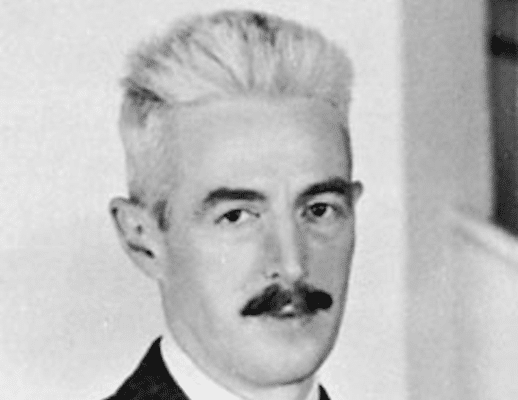Dashiell Hammett (1894-1961) has long been considered the most important writer of hard-boiled fiction. Not only did he give the genre its hallmarks in his short stories, but he also wrote three of its masterpieces in his novels. He was recognized immediately for lifting a previously disreputable style of fiction into literary prominence.
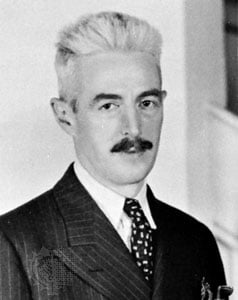 Born Samuel Dashiell Hammett on May 27, 1894 on a run-down Maryland farm, the writer took his mother’s maiden name as his own first name. The De Chiells had been respected in France for their bravery in battle. His mother, Annie, held herself better than her husband’s family, insisting that Dashiell’s name be pronounced with a French emphasis on the second syllable. Hammett’s father Richard was a profligate, frontier type who never held a job long, who drank every day, played poker every night, womanized when he could and fought when provoked. The Hammetts moved to Philadelphia, for Annie’s tuberculosis, and then to Baltimore, so Richard could work as a salesman, a job he soon lost. Hammett attended Public School #72, where he was known for his quick temper; but he also discovered the West Lexington Library, from which he borrowed armloads of adventures and mysteries. His hungry, eclectic reading became a life-long habit. There was a “year of study on the retina of the eye, how to play chess in your head; the Icelandic sagas; the history of the snapping turtle,” recalled Lillian Hellman later: “The picking up of any book, made for a remarkable mind, neat, accurate, respectful of fact.” 1
Born Samuel Dashiell Hammett on May 27, 1894 on a run-down Maryland farm, the writer took his mother’s maiden name as his own first name. The De Chiells had been respected in France for their bravery in battle. His mother, Annie, held herself better than her husband’s family, insisting that Dashiell’s name be pronounced with a French emphasis on the second syllable. Hammett’s father Richard was a profligate, frontier type who never held a job long, who drank every day, played poker every night, womanized when he could and fought when provoked. The Hammetts moved to Philadelphia, for Annie’s tuberculosis, and then to Baltimore, so Richard could work as a salesman, a job he soon lost. Hammett attended Public School #72, where he was known for his quick temper; but he also discovered the West Lexington Library, from which he borrowed armloads of adventures and mysteries. His hungry, eclectic reading became a life-long habit. There was a “year of study on the retina of the eye, how to play chess in your head; the Icelandic sagas; the history of the snapping turtle,” recalled Lillian Hellman later: “The picking up of any book, made for a remarkable mind, neat, accurate, respectful of fact.” 1
Reading helped Hammett qualify for the prestigious Baltimore Polytechnical Institute, which H. L. Mencken had attended, but he had to drop out at sixteen when his father became seriously ill. “Dashiell was elected to pick up the pieces,” his brother explained. The relationship between Hammett and his mother intensified when he became the family’s sole bread-winner, and he often declared “that he would never treat a woman the way his father treated his mother.” 2 Trapped by the petty tyrannies of an ill, vain, Southern husband, Annie Hammett was nonetheless too proud to feel sorry for herself. If you can’t hold a marriage together with love, she told neighbors, do it with sex. 3
Hammett, then fifteen, worked first as a messenger boy, then as a freight clerk, later as a stevedore, a timekeeper and a yardman for a railroad, but he never held a job long. When he was fired, Hammett created his first story: he had been late every day for a week, until the boss confronted him. Hammett shrugged nonchalantly and the boss relented: “Give me your word it won’t happen again.” But Hammett declined, figuring he would be late again and not wanting to break his word because of fate. 4 Early on, Hammett recognized the patterns in his own and others’ behavior, as well as the implausibility of overthrowing them.
He worked then as a nail machine operator and a day laborer, never keeping a job more than a year. He drank casually in corner saloons and acquired a venereal disease before twenty. “An enigmatic want-ad took me into the employ of the Pinkerton’s National Detective Agency,” he wrote, “and I stuck at that until early in 1922.” 5 His family was relieved, for the Pinkertons were thought an antidote for delinquency, much as the Marines are today. They were highly regimented, but on twenty-four hour call. The nature of the work–staking out houses, trailing suspects, often for weeks, reading files and writing reports–required great self-discipline. An agent who could not sit quietly to watch or listen, who could not tail unnoticed all day, was fired. The starting salary for this work was twenty-one dollars a week in 1915.
Hammett was a good agent. “Despite his size–he was 6’1 ½” and weighed about 160 at the time–he could follow a suspect all day without being observed,” writes biographer Richard Layman. 6 The manager of the Baltimore office was short, thick, tough-talking James Wright, a legend within the Pinkertons. From him Hammett learned a combination of insight, self-protection, policy, and survivor morality that allowed him to do his work well, with as little emotional and physical risk as possible. Key to Wright’s code, writes Layman, were anonymity, morality and objectivity:
A good detective must be anonymous, because the less known about him,the less his chances are of having personal information used against him. Agood detective neither seeks publicity nor accepts it easily if it comes his way.Accordingly, a Pinkerton operative’s reports were anonymous. He was identfied by number; one copy of his report was filed at the branch office and another, perhaps abridged or rewritten, was supplied to the client. A Pinkerton was expected to be close-mouthed and secretive about his job. Hammett, for instance, gave his occupation as “clerk” in the city directory while he was a detective in Baltimore. Later, while working as a part-time operative in San Francisco, he described himself as a “broker.” 7
Wright appears to have informed Hammett that morality was personal. The agent’s job, bluntly put, was to protect the good people from the bad, who did not live by civil or religious morality. To be bound by rules in dealing with them was to put oneself at a disadvantage. A detective could lie, cheat, steal evidence, break promises, blackmail and manipulate people in order to bring the criminal to justice. He owed the client results as much as he owed the agency his loyalty and the law his respect. The detective, Layman notes, had to develop a sense of priorities:
The essential quality which a detective must develop to avoid being consumed by his job is objectivity–an emotional distance from the people with whom he deals. If he becomes emotionally involved with a client, he will forfeit the objectivity required to gather all the available information and observe all the pertinent clues relating to the case. If he allows himself to hate a criminal, he will lose the emotional equilibrium required to protect himself and to make all his decisions coolly and logically. 8
Hammett’s Pinkerton work gave him not only material for stories, but an ethics and elements of his style. He quit the agency, however, to join the Army in 1918, when the U.S. declared war on the Axis powers. He trained as an ambulance driver but never left Maryland, spending most of his service fighting the first in a lifelong series of battles against tuberculosis and emphysema. When he emerged as a civilian in 1919, Hammett weighed only 140 pounds and was so weak he could not climb stairs or sit up for more than a few hours. He returned home, where his pension was $7.50 a week and then $50 a month as doctors declared him fifty percent disabled. But Hammett’s tuberculosis was cyclical, like his mother’s: during a long remission in the spring of 1920 he moved West, breaking all family ties. 9
He ended up in Spokane, Washington, working for the Pinkertons again. His cases took him into Idaho, Utah and Montana, where the International Workers of the World (I.W.W. or “Wobblies”) was organizing the miners. The West tolerated idealists, the dispossessed, settlements of Irish and Chinese who stayed after the railroads were built, Mormons and Catholics–but there was scant law enforcement to help the magnates whose fortunes were extracted from the mines. Hammett later told stories about organizing strike-breakers, arresting a giant track-worker and winning a confession when his car broke down overnight in a freezing mountain pass. He claimed to have worked on the case of the “Midget Bandit” and to have refused an offer to traffic in drugs, though none of this can be verified. One certain fact is that Hammett’s tuberculosis came back in 1920: he weighed only 132 pounds when he entered the Public Health Service hospital near Tacoma.10
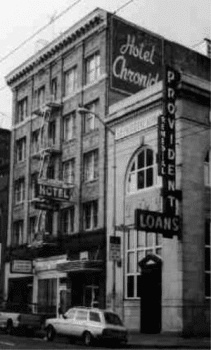 There Hammett, then 26, met a nurse, Jose Nolan, who became pregnant. After his release, he moved to an apartment in San Francisco (right), she followed, and they were married in 1921. Still frail, Hammett worked part-time as a Pinkerton. Even that, said Jose, took a toll. Layman calculates that he “could not have worked as a San Francisco detective for longer than eight months–half that length of time is more likely.” 11 He earned money as a book reviewer and advertising copy-writer, an area in which he also wrote for specialized journals. San Francisco was the metropolis of the West, where immigration, mining, agriculture, exports, industry, and such culture as invented locally or imported from the East, all converged. Politicians divided and conquered the huge immigrant population, and Prohibition was treated as a business opportunity. As newspaperman Herb Caen recalled:
There Hammett, then 26, met a nurse, Jose Nolan, who became pregnant. After his release, he moved to an apartment in San Francisco (right), she followed, and they were married in 1921. Still frail, Hammett worked part-time as a Pinkerton. Even that, said Jose, took a toll. Layman calculates that he “could not have worked as a San Francisco detective for longer than eight months–half that length of time is more likely.” 11 He earned money as a book reviewer and advertising copy-writer, an area in which he also wrote for specialized journals. San Francisco was the metropolis of the West, where immigration, mining, agriculture, exports, industry, and such culture as invented locally or imported from the East, all converged. Politicians divided and conquered the huge immigrant population, and Prohibition was treated as a business opportunity. As newspaperman Herb Caen recalled:
The City Hall, the D.A. and the cops ran the town as though they owned it, and they did. Hookers worked upstairs, not on the street; there were hundreds, maybe thousands, most of them named Sally. The two biggest abortion mills–one on Market, the other on Fillmore–were so well known they might as well have had neon signs. You could play roulette in the Marina, roll craps on O’Farrell, playpoker on Mason, get rolled at 4 a.m. in a bar on Eddy, and wake up at noon in a Turk Street hotel with a girl whose name you never knew or cared to know. 12
Hammett later claimed participation in four celebrated cases of the era. When silent movie star Fatty Arbuckle was tried in San Francisco for the rape/homicide of actress Virginia Rappe, he was among the Pinkertons assigned to protect Arbuckle. “The whole thing was a frame-up,” Hammett said, “arranged by some of the corrupt local newspaper boys. Arbuckle was good copy, so they set him up for a fall.” 13 Ironically, Hammett took a strong dislike to the rolly-polly Arbuckle, who was acquitted. A thin man himself, he used Arbuckle as the model for evil, lying characters.
Hammett also recounted his role in the arrest of Nicky Arnstein, whose theft of $1.5 million in bonds from a New York brokerage was a national story, but discrepancies in geography and time make it seem unlikely. He claimed to have fallen through a decaying porch roof while eavesdropping on bank robber Gloomy Gus Schaefer in Vallejo. But the date of this incident conflicts with another Hammett story: that he recovered $125,000 in English gold sovereigns hidden in a smokestack of the freighter Sonoma. 14 From this case, however, Hammett took the “treasure ship” motif of La Paloma in The Maltese Falcon; the other cases were similarly useful.
When his tuberculosis returned, Hammett moved first to the hallway and then out of his apartment, lodging in a rented room, to avoid infecting his new daughter. During the few hours a day he was out of bed, he attended Munson’s Business College, taking stenography, newspaper writing, and advertising. For the last he had a clear talent, and was hired by Albert Samuels, a chain jeweler. He was soon writing long columns of copy like this one:
It’s nothing unusual to find a man of position and excellent standing who istemporarily short of cash. The average man figures a long time ahead on the spending of his income. Besides his fixed expenses of rent, meals, clothing and recreation, he usually carries some kind of an investment, a savings account or life insurance, that pretty well takes care of all he earns. So when he finds himself engaged he may not have the cash necessary for the ring. We try to take care of men like that. 15
The publisher of the Oakland Post Enquirer wrote to Samuels that Hammett’s copy was the best advertising his paper had ever carried. The future hard-boiled novelist dismissed this as “applesauce, since he knows I’m thinking about cutting down the space used in the Oakland papers.” 16
Hammett also read The Black Mask and apparently noticed the stories of Carroll John Daly in late 1922. 17 His own writing efforts, however, he sent to Smart Set: “The Parthian Shot” appeared in October, 1922 and “The Great Lovers” in November. The problem was the pay–he made only $1.00 for each piece. Nevertheless he submitted “The Green Elephant” and “From the Memoirs of a Private Detective” in 1923. The latter consists of twenty-nine understated, humorous observations from cases Hammett had worked on. It is spare, ironic, and manages to leave even more implied than stated–as his advertising did. Whether he was advised to aim lower or decided for himself, Hammett was writing for Black Mask by mid-1923. The October, 1923 issue featured his Continental Op in “Arson Plus,” and a genre was born.
But the Hammetts were barely getting by. Dashiell devoted much time and energy to writing, and there was a baby to feed. He published the Op stories “Crooked Souls,” “It,” “The Second-Story Angel,” and “Bodies Piled Up” in 1923. Income from advertising work was sporadic, but his Black Mask career was rolling. In 1924 Hammett published the widely anthologized “The Tenth Clew” and ten other Op stories in Black Mask, his most productive year for the magazine. But just as the Veterans Bureau declared him 100% cured, Hammett’s tuberculosis flared up. His wife and child moved across the Bay for health, while he staggered from bed to bathroom. Samuels gave him some money. He managed seven stories for Black Mask in 1925, including two–“Dead Yellow Women” and “The Gutting of Couffignal”–that show him training for longer work. The next year the Hammetts had a second daughter, and Dashiell seemed better, but in July he was found unconscious at Samuels Jewelry, hemorrhaging from the lungs.
This is when “Cap” Shaw took over Black Mask and came to visit the bed-ridden ex-Pinkerton, bringing a doll for his daughter. There was a publication gap of almost a year before “The Big Knockover,” a novella, appeared in February, 1927. Another novella (“$106,000 Blood Money”) followed in May, and then four stories, beginning with “The Cleansing of Poisonville” in November, 1927, which would constitute Red Harvest.
By spring 1927, just as the Veterans Bureau caught up and declared him 100% disabled, Hammett was well enough to return to advertising work. Jose and his daughters were now living apart, and Hammett was wooing other women, while drinking liberally. He also reviewed detective novels for the Saturday Review. Philo Vance, he wrote, was like “a high-school girl who had been studying the foreign words and phrases in the back of her dictionary. He is a bore…. [He] manages always, and usually ridiculously, to be wrong.” 18
If 1928 shows a drop in Hammett’s Black Mask publications (four stories), it is because he was preparing the manuscript of Red Harvest, which arrived “over the transom”–unsolicited–at Alfred Knopf Inc. in New York. The publisher’s wife screened this “slush pile,” and she liked the manuscript. She suggested revisions, which Hammett completed in eight days. 19
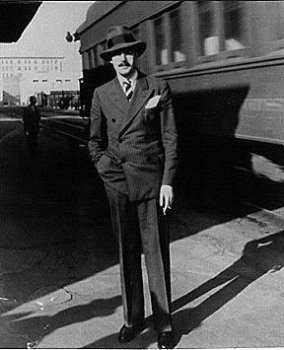 Red Harvest did not appear until early 1929, but Hammett was at work on his second novel,The Dain Curse. And his August 1928, correspondence already mentions The Maltese Falcon. The novels appeared in machine-gun succession: The Dain Curse in July 1929, and The Maltese Falcon in the spring of 1930. Hammett became famous.Ten years after he left the East, he returned a celebrity. Hammett parked Jose and his daughters in L.A. and went to New York with his new love, writer Nell Martin. The Maltese Falcon was universally praised by reviewers, achieving a renown that made Hammett the toast of Manhattan café life. Dorothy Parker, who “discovered” him for The New Yorker, later wrote that “I went mooning about in a daze of love [for Spade] such as I had not known for any character in literature since I encountered Sir Launcelot.” 20The tall, sartorial Hammett, his prematurely silvered hair combed back in a pompadour, became a literary celebrity just as the Stock Market crashed and the economy went to pieces. Warner Brothers bought the rights to Red Harvest in 1929, and Hammett signed on to write for Paramount. 21 First, however, he finished his most hard-boiled work ever, The Glass Key, in a marathon session of 30 hours. 22What happened to Nell Martin is not known, but after Hammett arrived in L.A. he became the companion of a young script-reader named Lillian Hellman, who was later a famous playwright. “When I first met Dash, he had written the four novels and was the hottest thing in Hollywood and New York,” she wrote. “It was of interest to those who collect people that the ex-detective who had bad cuts on his legs and an indentation in his head from being scrappy with criminals was gentle in manner, well educated, elegant to look at, born of early settlers, was eccentric, witty, and spent so much money on women that they would have liked him even if he had been none of the good things.” 23Hammett lived well, as money poured through his hands. He and Hellman shuttled from L.A. to New York, where he finally settled in at a hotel managed by Nathanael West to work on The Thin Man. Hammett and Hellman drank with West and the visiting William Faulkner late into the night, arguing about books and art. When Hammett got serious about his book, said Hellman, “life changed. The drinking stopped, the parties were over. The locking in time had come and nothing was allowed to disturb it until the book was finished. I had never seen anybody work that way; the care for every word, the pride in the neatness of the typed page itself, the refusal for ten days or two weeks to go out even for a walk for fear something would be lost.” 24The story of Nick and Nora Charles went through several drafts and reflects Hammett’s changed circumstances. Nick is a bon vivant, his wife a charmer, the dialogue high-speed repartee with sexual overtones. Asta, their Schnauzer, is no minor part of the charm. appeared in 1934 and became a very successful movie series, starring William Powell and Myrna Loy (right). Hammett received royalties on the The Thin Man original and on the characters, which he spent liberally. This was the pattern of the next decade of his life. Aside from movie scripts, he wrote little and drank much. Royalties from his early stories, from Sam Spade–who eventually became a comic book, a radio show, and whose exploits were filmed in three versions of The Maltese Falcon – kept Hammett’s wallet filled. “I mean to live flamboyantly,” he said. 25 Money from The Thin Man movies and spin-offs redoubled his ability.Although The Thin Man was not an immediate best-seller, Layman writes that “Hammett was able to live off the characters he created… for a long time.” The novel sold well –34,000 copies at $2 each during the first 18 months— but the serialization in Redbook, the movie rights and spin-offs brought in nearly $1 million by 1950. 26 M.G.M. hired Hammett for $2,000 a week and he began “throwing around the money from The Thin Man,” wrote Hellman, who was writing the successful The Children’s Hour and establishing an independent artistic life. 27 From his Hollywood penthouse, Hammett managed to work on six movie scripts, but he left unpaid bills everywhere and developed a reputation for undependability. His epic drinking finally overtook him in New York in 1936, when he went to Lennox Hill Hospital to dry out. 28
Red Harvest did not appear until early 1929, but Hammett was at work on his second novel,The Dain Curse. And his August 1928, correspondence already mentions The Maltese Falcon. The novels appeared in machine-gun succession: The Dain Curse in July 1929, and The Maltese Falcon in the spring of 1930. Hammett became famous.Ten years after he left the East, he returned a celebrity. Hammett parked Jose and his daughters in L.A. and went to New York with his new love, writer Nell Martin. The Maltese Falcon was universally praised by reviewers, achieving a renown that made Hammett the toast of Manhattan café life. Dorothy Parker, who “discovered” him for The New Yorker, later wrote that “I went mooning about in a daze of love [for Spade] such as I had not known for any character in literature since I encountered Sir Launcelot.” 20The tall, sartorial Hammett, his prematurely silvered hair combed back in a pompadour, became a literary celebrity just as the Stock Market crashed and the economy went to pieces. Warner Brothers bought the rights to Red Harvest in 1929, and Hammett signed on to write for Paramount. 21 First, however, he finished his most hard-boiled work ever, The Glass Key, in a marathon session of 30 hours. 22What happened to Nell Martin is not known, but after Hammett arrived in L.A. he became the companion of a young script-reader named Lillian Hellman, who was later a famous playwright. “When I first met Dash, he had written the four novels and was the hottest thing in Hollywood and New York,” she wrote. “It was of interest to those who collect people that the ex-detective who had bad cuts on his legs and an indentation in his head from being scrappy with criminals was gentle in manner, well educated, elegant to look at, born of early settlers, was eccentric, witty, and spent so much money on women that they would have liked him even if he had been none of the good things.” 23Hammett lived well, as money poured through his hands. He and Hellman shuttled from L.A. to New York, where he finally settled in at a hotel managed by Nathanael West to work on The Thin Man. Hammett and Hellman drank with West and the visiting William Faulkner late into the night, arguing about books and art. When Hammett got serious about his book, said Hellman, “life changed. The drinking stopped, the parties were over. The locking in time had come and nothing was allowed to disturb it until the book was finished. I had never seen anybody work that way; the care for every word, the pride in the neatness of the typed page itself, the refusal for ten days or two weeks to go out even for a walk for fear something would be lost.” 24The story of Nick and Nora Charles went through several drafts and reflects Hammett’s changed circumstances. Nick is a bon vivant, his wife a charmer, the dialogue high-speed repartee with sexual overtones. Asta, their Schnauzer, is no minor part of the charm. appeared in 1934 and became a very successful movie series, starring William Powell and Myrna Loy (right). Hammett received royalties on the The Thin Man original and on the characters, which he spent liberally. This was the pattern of the next decade of his life. Aside from movie scripts, he wrote little and drank much. Royalties from his early stories, from Sam Spade–who eventually became a comic book, a radio show, and whose exploits were filmed in three versions of The Maltese Falcon – kept Hammett’s wallet filled. “I mean to live flamboyantly,” he said. 25 Money from The Thin Man movies and spin-offs redoubled his ability.Although The Thin Man was not an immediate best-seller, Layman writes that “Hammett was able to live off the characters he created… for a long time.” The novel sold well –34,000 copies at $2 each during the first 18 months— but the serialization in Redbook, the movie rights and spin-offs brought in nearly $1 million by 1950. 26 M.G.M. hired Hammett for $2,000 a week and he began “throwing around the money from The Thin Man,” wrote Hellman, who was writing the successful The Children’s Hour and establishing an independent artistic life. 27 From his Hollywood penthouse, Hammett managed to work on six movie scripts, but he left unpaid bills everywhere and developed a reputation for undependability. His epic drinking finally overtook him in New York in 1936, when he went to Lennox Hill Hospital to dry out. 28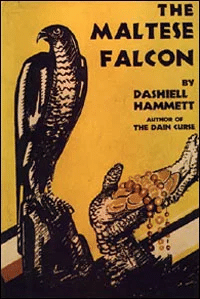 When he emerged, Hammett took a leftward political turn, perhaps in reaction to the easy money or in response to the Depression. In 1937 he was active in the Loyalist cause during the Spanish Civil War. He worked for the Screenwriters Guild and he joined the American Communist Party. In 1941 John Huston filmed the third and most famous version of The Maltese Falcon, starring Humphrey Bogart, but Hammett played no active part. He was busy trying to join the Army to fight Fascism. Rejected several times–he was forty-seven, had tuberculosis and bad teeth–he was finally accepted in 1942 and sent to edit a camp newspaper at Adak in the Aleutian Islands.
When he emerged, Hammett took a leftward political turn, perhaps in reaction to the easy money or in response to the Depression. In 1937 he was active in the Loyalist cause during the Spanish Civil War. He worked for the Screenwriters Guild and he joined the American Communist Party. In 1941 John Huston filmed the third and most famous version of The Maltese Falcon, starring Humphrey Bogart, but Hammett played no active part. He was busy trying to join the Army to fight Fascism. Rejected several times–he was forty-seven, had tuberculosis and bad teeth–he was finally accepted in 1942 and sent to edit a camp newspaper at Adak in the Aleutian Islands.
After the war he lived at first outside New York on Lillian Hellman’s estate and later, when his drinking worsened, by himself in a city apartment. He was a committed leftist during this period, and in 1951 he was sent to prison for refusing to testify in Federal court about the bail fund of the Civil Rights Congress, of which he was a trustee. 29 He served twenty-two weeks, then found himself in trouble with the I.R.S. when released, because he owed back taxes dating to 1943. 30 Though he made one more effort at writing–a semi-autobiographical fragment called Tulip—Hammett spent the last nine years of his life as a dependent of Hellman and other benefactors. His earlier drinking had weakened him, and prison broke his health. He had a heart attack in 1955, and he died January 10, 1961, at Lennox Hill Hospital. As Raymond Chandler wrote, “He was spare, frugal, hard-boiled, but he did over and over again what only the best writers can ever do at all. He wrote scenes that seemed never to have been written before.” 31
Notes:
1 Biographic facts from William Marling, Dashiell Hammett Boston: Twayne, 1983, 1-4. Original sources in William Nolan, Dashiell Hammett;: A Casebook, Santa Barbara, Cal.: McNally & Loftin, 1969; Lillian Hellman, An Unfinished Woman, New York, Bantam, 1979; Richard Layman, Shadow Man: The Life of Dashiell Hammett. New York, Harcourt, 1981; and Diane Johnson, Dashiell Hammett : A Life. New York: Random, 1983. Quotation from Hellman, 238.
2 Layman, 8.
3 Ibid.
4 Hellman, 271.
5 Dashiell Hammett, letter in Black Mask, 7, no. 9 (November, 1924), 128.
6 Layman, 11.
7 Ibid.
8 Ibid.
9 Marling, 7-8.
10 Hammett, “From the Memoirs of a Private Detective,” Smart Set 70, no. 3 (March 1923), 88-90.; Hellman, 227; Nolan, 13-16; Layman, 17.
11 Layman, 22
12 Herb Caen, “Nights of Old,” San Francisco Chronicle, November 25, 1967.
13 Hammett, “Seven Pages,” manuscript, Humanities Research Center, U. of Texas at Austin.
14 Layman, 24-25.
15 Hammett in Johnson, 39.
16 Johnson, 66.
17 Johnson, 43.
18 Johnson, 62.
19 Johnson, 71-73.
20 Dorothy Parker, The New Yorker, April 25, 1931, 91.
21 Layman, 125-27.
22 Ibid. 115.
23 Hellman, 228, 226.
24 Hellman, 236.
25 Hammett in Johnson, 136.
26 Layman, 141.
27 Hellman, Pentimento (New York: Signet, 1973), 101.
28 Marling, 114.
29 See Johnson, pp. 238-49 and Layman, pp. 219-32 for details of the trials.
30 Layman, 224.
31 Raymond Chandler, “The Simple Art of Murder,” in The Simple Art of Murder (New York: Ballantine, 1972), 16-17.

